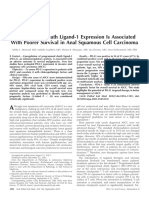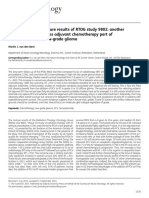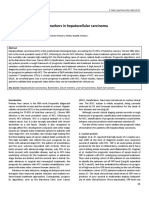Science
Science
Uploaded by
Quique TinocoCopyright:
Available Formats
Science
Science
Uploaded by
Quique TinocoCopyright
Available Formats
Share this document
Did you find this document useful?
Is this content inappropriate?
Copyright:
Available Formats
Science
Science
Uploaded by
Quique TinocoCopyright:
Available Formats
Comment
In the meantime, who should receive dose-intensied treatment? Rcher and colleagues report convincing evidence that patients younger than 59 years with an International Prognostic Index of 1, who can tolerate the additional toxic eects of R-ACVBP with consolidation, do have a better 3-year event-free survival. Unfortunately, some of the drugs in the regimen are not available in all countries and testing of substitute drugs or modications would be needed. Furthermore, a direct comparison of other dose-intensive chemotherapy regimens such as a dose-adjusted regimen of rituximab, etoposide, vincristine, cyclophosphamide, and doxorubicin (R-EPOCH)11 versus the R-ACVBP regimen is needed, pending the results of the present R-CHOP versus dose-adjusted R-EPOCH protocol being done by the United States Cooperative Group Mechanism (registered with ClinicalTrials.gov, number NCT00118209). Although we continue to identify subsets of patients at higher risk, further international clinical trials are needed to assess the best individualised approach to treatment for these patients. Julie M Vose
Division of Hematology/Oncology, Nebraska Medical Center, Omaha, NE 68198, USA jmvose@unmc.edu
I declare that I have no conicts of interest.
6 7
10
11
Rcher C, Coier B, Haioun C, et al, for the Groupe dEtude des Lymphomes de lAdulte. Intensied chemotherapy with ACVBP plus rituximab versus standard CHOP plus rituximab for the treatment of diuse large B-cell lymphoma (LNH03-2B): an open-label randomised phase 3 trial. Lancet 2011; 378: 185867. The International Non-Hodgkins Lymphoma Prognostic Factors Project. A predictive model for aggressive non-Hodgkins lymphoma. N Engl J Med 1993; 329: 98794. Pfreundschuh M, Trumper L, Osterborg A, et al. CHOP-like chemotherapy plus rituximab versus CHOP-like chemotherapy alone in young patients with good-prognosis diuse large-B-cell lymphoma: a randomised controlled trial by the MabThera International Trial (MInT) Group. Lancet Oncol 2006; 7: 37991. Tilly H, Lepage E, Coier B, et al. Intensive conventional chemotherapy (ACVBP regimen) compared with standard CHOP for poor-prognosis aggressive non-Hodgkin lymphoma. Blood 2003; 102: 428489. Rosenwald A, Wright G, Chan WC, et al. The use of molecular proling to predict survival after chemotherapy for diuse large-B-cell lymphoma. N Engl J Med 2002; 346: 193747. Aukema SM, Siebert R, Schuuring E, et al. Double-hit B-cell lymphomas. Blood 2011; 117: 231931. Casasnovas RO, Meignan M, Berriolo-Riedinger A, et al. SUVmax reduction improves early prognosis value of interim positron emission tomography scans in diuse large B-cell lymphoma. Blood 2011; 118: 3743. Nowakowski GS, Laplant B, Habermann TM, et al. Lenalidomide can be safely combined with R-CHOP (R2CHOP) in the initial chemotherapy for aggressive B-cell lymphomas: phase I study. Leukemia 2011; published online July 1. DOI:10.1038/leu.2011.165. Ruan J, Martin P, Furman RR, et al. Bortezomib plus CHOP-rituximab for previously untreated diuse large B-cell lymphoma and mantle cell lymphoma. J Clin Oncol 2010; 29: 69097. Advani RH, Sharman JP, Smith SM, et al. The Btk inhibitor PCI-32765 is highly active and well tolerated in patients (pts) with relapsed/refractory B cell malignancies: nal results from a phase I study. Ann Oncol 2011; 22 (suppl 4): iv13537. Wilson WH, Dunleavy K, Pitaluga S, et al. Phase II study of dose-adjusted EPOCH and rituximab in untreated diuse large B-cell lymphoma with analysis of germinal center and post-germinal center biomarkers. J Clin Oncol 2008; 26: 271724.
Prevention of cervical cancer in womens hands: Mexico leads the way
In The Lancet,1 Eduardo Lazcano-Ponce and colleagues report the results of the rst community-based randomised trial to compare the eectiveness of HPV DNA testing of vaginal samples self-collected at home with clinician-collected cervical cytology, for detection of prevalent cervical intraepithelial neoplasia (CIN) grade 2 or greater. The trial randomly assigned 20 256 Mexican women aged between 25 and 65 years of low socioeconomic status to self-collection of samples for HPV testing (n=9202) or to clinicancollected cervical cytology (n=11 054). Women who were HPV positive or had cytological abnormalities (mild dysplasia or worse) were referred for diagnostic colposcopy and biopsies as needed. The detection rate of cytological abnormalities was 038% (95% CI 023045), which is lower than usually
www.thelancet.com Vol 378 November 26, 2011
reported.2 This nding indicates low-quality cytology and shows the challenge of using this technique in developing countries. Absence of inclusion of atypical squamous cells of undetermined signicance among the cytological abnormalities is unlikely to explain this low prevalence. That mild cytological lesions were almost completely undetected in the study is particularly noteworthy and explains the very high (905% [617100]) positive predictive value of cytology. By contrast, the detected HPV prevalence was roughly 10%, with a correspondingly low positive predictive value (122% [99145]), increasing with age as expected. HPV testing detected 34 times (2449) more prevalent CIN2 and greater, and 42 times (1992) more invasive cervical cancers than cytology, which clearly indicates that HPV testing of selfcollected vaginal specimens is better than cytology.
Published Online November 2, 2011 DOI:10.1016/S01406736(11)61101-X See Articles page 1868
1829
You might also like
- 4 Microbiology Lab Report Practical 3 PDFDocument10 pages4 Microbiology Lab Report Practical 3 PDFNurul IzzahNo ratings yet
- Rituximab Extended Schedule or Re-Treatment Trial For Low-Tumor Burden Follicular Lymphoma: Eastern Cooperative Oncology Group Protocol E4402Document9 pagesRituximab Extended Schedule or Re-Treatment Trial For Low-Tumor Burden Follicular Lymphoma: Eastern Cooperative Oncology Group Protocol E4402Ramiro TupayachiNo ratings yet
- 1857 FullDocument6 pages1857 FullTahniat AishaNo ratings yet
- COGNITION A Prospective Precision Oncology TrialDocument12 pagesCOGNITION A Prospective Precision Oncology Trialveaceslav coscodanNo ratings yet
- 33Document11 pages33Joana KellenNo ratings yet
- Jco 2015 64 8931Document10 pagesJco 2015 64 8931Kamila MuyasarahNo ratings yet
- (583950958) Journal Leucopenia Treatment Effiicacy NPCDocument8 pages(583950958) Journal Leucopenia Treatment Effiicacy NPCDaniel HoseaNo ratings yet
- Clinical StudyDocument7 pagesClinical StudyTit fuckerNo ratings yet
- 1677 5538 Ibju 42 04 0694Document10 pages1677 5538 Ibju 42 04 0694Lucas VibiamNo ratings yet
- Artículo 5Document7 pagesArtículo 5liz jimaNo ratings yet
- Sequential Chemoradiotherapy With Gemcitabine and Cisplatin For Locoregionally Advanced Nasopharyngeal CarcinomaDocument9 pagesSequential Chemoradiotherapy With Gemcitabine and Cisplatin For Locoregionally Advanced Nasopharyngeal CarcinomadheaonyonNo ratings yet
- Prognostic Factors in Nasopharyngeal Carcinoma With Synchronous Liver Metastasis: A Retrospective Study For The Management of TreatmentDocument7 pagesPrognostic Factors in Nasopharyngeal Carcinoma With Synchronous Liver Metastasis: A Retrospective Study For The Management of TreatmentChairul Nurdin AzaliNo ratings yet
- Sabcs 2014 AllabstractsDocument1,508 pagesSabcs 2014 Allabstractsrajesh4189No ratings yet
- Treatment of Older Patients With Mantle-Cell Lymphoma: Original ArticleDocument12 pagesTreatment of Older Patients With Mantle-Cell Lymphoma: Original ArticleChoirul WizaNo ratings yet
- Prognostic Value of Changes in Neutrophil-To-Lymphocyte Ratio (NLR) and PLRDocument6 pagesPrognostic Value of Changes in Neutrophil-To-Lymphocyte Ratio (NLR) and PLRdominguezmariela465No ratings yet
- Theoncologist 15440Document8 pagesTheoncologist 15440nimaelhajjiNo ratings yet
- A Novel Radiogenomics Biomarker For Predicting Treatment Response and Pneumotoxicity From Programmed Cell Death Protein or Ligand-1 Inhibition Immunotherapy in NSCLCDocument13 pagesA Novel Radiogenomics Biomarker For Predicting Treatment Response and Pneumotoxicity From Programmed Cell Death Protein or Ligand-1 Inhibition Immunotherapy in NSCLCJOSE DIAZNo ratings yet
- Drugs in Context: Rigorous - Rapid - ResponsiveDocument10 pagesDrugs in Context: Rigorous - Rapid - ResponsiveAkande AbdulazeezNo ratings yet
- Background: Nivolumab For Recurrent Squamous-Cell Carcinoma of The Head and NeckDocument10 pagesBackground: Nivolumab For Recurrent Squamous-Cell Carcinoma of The Head and NeckjoitNo ratings yet
- PD-1 High Expression Predicts Lower Local Disease Control in Stage IV M0 Nasopharyngeal CarcinomaDocument11 pagesPD-1 High Expression Predicts Lower Local Disease Control in Stage IV M0 Nasopharyngeal CarcinomaConstantin StanNo ratings yet
- PDL1Document12 pagesPDL1Arlen ElisaNo ratings yet
- Monoclonal Antibodies New Chance in The Management of B Cell Acute Lymphoblastic LeukemiaDocument12 pagesMonoclonal Antibodies New Chance in The Management of B Cell Acute Lymphoblastic LeukemiaMayra AlejandraNo ratings yet
- 2021 Consolidation Theraphy in Esophageal CancerDocument6 pages2021 Consolidation Theraphy in Esophageal CancerykommNo ratings yet
- Combined Nivolumab and Ipilimumab or Monotherapy in Untreated MelanomaDocument12 pagesCombined Nivolumab and Ipilimumab or Monotherapy in Untreated MelanomaIndra PermanaNo ratings yet
- An Expanding Role For Immunotherapy in Colorectal CancerDocument10 pagesAn Expanding Role For Immunotherapy in Colorectal CancercollianairaNo ratings yet
- PIIS0923753419310762Document7 pagesPIIS0923753419310762Kamila MuyasarahNo ratings yet
- Early Stage TNBC - Management and Future Directions 2020Document21 pagesEarly Stage TNBC - Management and Future Directions 2020VistieruBeatriceNo ratings yet
- Pancreatic Cancer Literature ReviewDocument10 pagesPancreatic Cancer Literature Reviewea813c29No ratings yet
- v20n2 103usingDocument7 pagesv20n2 103usingHuỳnh Minh ĐôngNo ratings yet
- Programmed Death Ligand-1 Expression Is Associated With Poorer Survival in Anal Squamous Cell CarcinomaDocument8 pagesProgrammed Death Ligand-1 Expression Is Associated With Poorer Survival in Anal Squamous Cell CarcinomaAnu ShaNo ratings yet
- Baumann 2013Document8 pagesBaumann 2013nimaelhajjiNo ratings yet
- Liau Et Al. - 2018 - First Results On Survival From A Large Phase 3 Clinical Trial of An Autologous Dendritic Cell Vaccine in Newly DiagDocument9 pagesLiau Et Al. - 2018 - First Results On Survival From A Large Phase 3 Clinical Trial of An Autologous Dendritic Cell Vaccine in Newly DiagJoeyOrpillaNo ratings yet
- 1 s2.0 S1525730423002681 MainDocument10 pages1 s2.0 S1525730423002681 MainTrọngNguyễnĐìnhNo ratings yet
- Cha BH Clin Endosc. 2021 Survival Benefit of Intraductal Radiofrequency Ablation For Malignant Biliary Obstruction Meta Ce-2020-254Document7 pagesCha BH Clin Endosc. 2021 Survival Benefit of Intraductal Radiofrequency Ablation For Malignant Biliary Obstruction Meta Ce-2020-254Byung ChaNo ratings yet
- Diffuse Large B Cell LymphomaDocument8 pagesDiffuse Large B Cell LymphomaMaryanti RensiNo ratings yet
- Prognostic Relevance of Early Radiologic Response To Induction Chemotherapy in PediatricDocument9 pagesPrognostic Relevance of Early Radiologic Response To Induction Chemotherapy in Pediatricaperezvaldes45No ratings yet
- Singal Et Al-2013-Alimentary Pharmacology & TherapeuticsDocument9 pagesSingal Et Al-2013-Alimentary Pharmacology & TherapeuticsRizko Putra PradanaNo ratings yet
- Is Adjuvant Chemotherapy Useful For Women With Luminal A Breast Cancer?Document4 pagesIs Adjuvant Chemotherapy Useful For Women With Luminal A Breast Cancer?maur_jmpNo ratings yet
- Non-Hodgkin Lymphoma of The Breast: MD MD MD PHD MDDocument6 pagesNon-Hodgkin Lymphoma of The Breast: MD MD MD PHD MDlPiNGUSlNo ratings yet
- Comparative Efficacy of Different Chemotherapies For Non-Hodgkin Lymphoma: A Network-Meta AnalysisDocument10 pagesComparative Efficacy of Different Chemotherapies For Non-Hodgkin Lymphoma: A Network-Meta AnalysisRicky Cornelius TariganNo ratings yet
- 247 FullDocument10 pages247 FullMeidianty TandiNo ratings yet
- HPV Vaccine Programmes - Current Scenario and Recommendations in IndiaDocument3 pagesHPV Vaccine Programmes - Current Scenario and Recommendations in Indiash19782001No ratings yet
- Childhood NHL TXDocument9 pagesChildhood NHL TXsccNo ratings yet
- Christodouleas 2014Document9 pagesChristodouleas 2014nimaelhajjiNo ratings yet
- Mir-155-5P Modulates Malignant Behaviors Of Hepatocellular Carcinoma By Directly Targeting Cthrc1 And Indirectly Regulating Gsk-3Β-Involved Wnt/Β-Catenin SignalingDocument12 pagesMir-155-5P Modulates Malignant Behaviors Of Hepatocellular Carcinoma By Directly Targeting Cthrc1 And Indirectly Regulating Gsk-3Β-Involved Wnt/Β-Catenin SignalingDeedee RenovaldiNo ratings yet
- A Randomized Phase II Trial of Best Supportive Care With or 2020 Journal ofDocument8 pagesA Randomized Phase II Trial of Best Supportive Care With or 2020 Journal ofmarkvdtienNo ratings yet
- (Current Clinical Oncology) Brian I. Carr (Eds.) - Hepatocellular Carcinoma - Diagnosis and Treatment-Springer International Publishing (2016)Document594 pages(Current Clinical Oncology) Brian I. Carr (Eds.) - Hepatocellular Carcinoma - Diagnosis and Treatment-Springer International Publishing (2016)thanhNo ratings yet
- Nou 297Document5 pagesNou 297ObamaNo ratings yet
- Hepb y RTX PDFDocument3 pagesHepb y RTX PDFYeli VeMeNo ratings yet
- Radioimmunotherapy With Tositumomab and Iodine-131 Tositumomab For Non-Hodgkin's LymphomaDocument8 pagesRadioimmunotherapy With Tositumomab and Iodine-131 Tositumomab For Non-Hodgkin's LymphomaVera MirandaNo ratings yet
- 10 1016@j Hoc 2019 03 006-2Document12 pages10 1016@j Hoc 2019 03 006-2Bruna AngeloNo ratings yet
- TNBC PMRTDocument7 pagesTNBC PMRTMed MedNo ratings yet
- 1 s2.0 S0090825820313573 MainDocument2 pages1 s2.0 S0090825820313573 MainRebeca IbaFerNo ratings yet
- Tmp9a87 TMPDocument3 pagesTmp9a87 TMPFrontiersNo ratings yet
- Early Stage TNBC - Time To Optimize Personalized Strategies 2022Document10 pagesEarly Stage TNBC - Time To Optimize Personalized Strategies 2022VistieruBeatriceNo ratings yet
- BCTT 8 093Document15 pagesBCTT 8 093Luis SanchezNo ratings yet
- Regimen Calgb 8811Document14 pagesRegimen Calgb 8811ricardo_cheNo ratings yet
- Clinical Impact of PD-L1 Expression in Triple-Negative Breast Cancer Patients With Residual Tumor Burden After Neoadjuvant ChemotherapyDocument9 pagesClinical Impact of PD-L1 Expression in Triple-Negative Breast Cancer Patients With Residual Tumor Burden After Neoadjuvant ChemotherapyArabian NightsNo ratings yet
- JCO 2014 Ñamendys Silva 1169 70Document2 pagesJCO 2014 Ñamendys Silva 1169 70Eward Rod SalNo ratings yet
- Large-Scale Screening For Somatic Mutations in Lung CancerDocument3 pagesLarge-Scale Screening For Somatic Mutations in Lung CancerAriNo ratings yet
- Cytological TechniquesDocument4 pagesCytological TechniquesJamie100% (2)
- Salter, J. (2014) - Behind The Screen. Demos, London.Document122 pagesSalter, J. (2014) - Behind The Screen. Demos, London.brenderdanNo ratings yet
- Identifikasi Bakteri Dengan Pewarnaan Gram Pada Penderita Infeksi Mata Luar Di Rumah Sakit Mata Kota ManadoDocument7 pagesIdentifikasi Bakteri Dengan Pewarnaan Gram Pada Penderita Infeksi Mata Luar Di Rumah Sakit Mata Kota ManadoMaria YolanditaNo ratings yet
- Gram Staining:: Gram-Negative Bacteria Such As The Salmonella Typhi That Is Associated With Typhoid Fever. PurposeDocument2 pagesGram Staining:: Gram-Negative Bacteria Such As The Salmonella Typhi That Is Associated With Typhoid Fever. PurposeIravati RayNo ratings yet
- His To PathologyDocument52 pagesHis To PathologyRathinaKumarNo ratings yet
- Activity Sheet For Lab 2 On Gram's StainingDocument5 pagesActivity Sheet For Lab 2 On Gram's Stainingfranyce thomasNo ratings yet
- Different Staing MethodDocument35 pagesDifferent Staing MethodAnik Alam100% (1)
- Cervical Cancer Screening ThesisDocument6 pagesCervical Cancer Screening Thesisbk1svxmr100% (3)
- A1-Peran Klinisi - BiopsiDocument43 pagesA1-Peran Klinisi - BiopsiJemmy SusatiaNo ratings yet
- 11460.oral Cancer Research Advances by Alexios P. NikolakakosDocument320 pages11460.oral Cancer Research Advances by Alexios P. NikolakakosZoilo NuñezNo ratings yet
- Lecture 2Document15 pagesLecture 2Mehran AsimNo ratings yet
- Canine and Feline Skin Cytology-1Document10 pagesCanine and Feline Skin Cytology-1Hernany BezerraNo ratings yet
- Pap StainDocument60 pagesPap StainvikithiruvarooranNo ratings yet
- A - Final - Pengantar Patologi - 2020Document75 pagesA - Final - Pengantar Patologi - 2020Chaca SafinarNo ratings yet
- Session 1 Basic Concepts of PathologyDocument33 pagesSession 1 Basic Concepts of PathologyJamex MagachaNo ratings yet
- Gram StainingDocument13 pagesGram Stainingzahra__100% (1)
- Routine Histological TechniquesDocument133 pagesRoutine Histological TechniquesHussien HamidNo ratings yet
- List Approved Titile Dissertation 1011 Medical 090811Document53 pagesList Approved Titile Dissertation 1011 Medical 090811ZainMalikNo ratings yet
- Template Laboratory Request Form - 0Document2 pagesTemplate Laboratory Request Form - 0elmore kakaNo ratings yet
- Gram-Staining LabDocument4 pagesGram-Staining Labapi-419388203No ratings yet
- Treating Cancer - Amazing Info On Cancer From Lifeone Dr.Document31 pagesTreating Cancer - Amazing Info On Cancer From Lifeone Dr.angelzinfoNo ratings yet
- Simple Stain Differential StainDocument2 pagesSimple Stain Differential StainmomoNo ratings yet
- Lesson 2 - Administrative Order No. 2021-0037Document10 pagesLesson 2 - Administrative Order No. 2021-0037Marjan CalzadoNo ratings yet
- Isma FnaDocument1 pageIsma FnaTalking Tom ReciteNo ratings yet
- Harsh Mohan Textbook of Pathology, 7th Edition-17-180Document164 pagesHarsh Mohan Textbook of Pathology, 7th Edition-17-180Vikash Kr GurjarNo ratings yet
- Exfoliative Respiratory Cytology (Part 1 of 2)Document15 pagesExfoliative Respiratory Cytology (Part 1 of 2)Jenn100% (2)
- Lab Exercise 14,15,16 MicrobioDocument4 pagesLab Exercise 14,15,16 Microbiotaylorstack18No ratings yet
- Pap Stain Introduction, Principle, Staining ProcDocument1 pagePap Stain Introduction, Principle, Staining ProcSuchana AcNo ratings yet
- Acid-Fast StainingDocument2 pagesAcid-Fast StainingJames Emman ClementeNo ratings yet

























































































